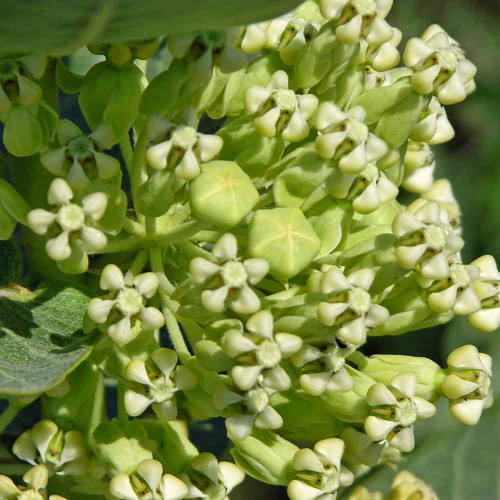Description
Vining Milkweed - Explosion of Color and Shade
Vining Milkweed is an evergreen vine that earns its name. This tough, vigorous plant is native to California, Utah, and Arizona and is often found climbing or twining up to 10 -15 feet long on neighboring bushes and shrubs in dry washes of the Mojave and Colorado deserts. It forms an extensive network of vines, climbing everything nearby while creating shade with its leaves and a canopy of delicate cream-colored blossoms slightly brushed with pink when in bloom. The explosion of color and shade in otherwise arid washes creates striking memories for many hikers who come upon it.
Perennial in its native habitats, it is grown as a tender annual elsewhere, making an excellent addition to the nature-scape or wildflower garden as a larval host plant for the Monarch Butterfly and Queen Butterfly. The abundance of attractive flowers readily attracts butterflies and other pollinators.
The long, narrow stems carry many arrowhead-shaped leaves on opposite sides of the stem that are somewhat variably shaped, from narrow and linear to wider and ovate.
Finding quality Vining Milkweed seed with good germination and vigor has been difficult, but AZ Milkweed for Monarchs has been cultivating, selecting, and collecting seeds through their citizen science program to supply this hard-to-find variety to home gardeners through our partnership.
Details
Vining milkweed’s preferred habitat is dry streams and washes, sandy areas, and climbing over shrubs and small trees, and in cultivated areas, it is often densely woven into and along fences. Riparian and disturbed areas with slight but steady soil moisture are where the largest growth is seen in the wild.
An unusual characteristic of this milkweed is the scent of the sap, as it smells like hot rubber, making identification easier.
It typically is found growing wild at 1,500 to 4,500 feet elevations.
Flowers
April to September.
Will These Grow in My Area?
The range of these milkweed species is not limited to Arizona but in most cases the entire southwest and beyond. Refer to the USDA map link and please realize that a milkweed species can grow and thrive outside of the areas listed if the conditions are favorable.
From that link, you’ll see the states shown where the milkweed is native. If you find a state that has areas with climate and conditions similar to yours, then that milkweed will most likely do very well for you.
Pods
The milkweed seed pod contains a seed floss – called pappas – that is used to stuff pillows or mixed with other fibers to make a cloth. It is used in Life Jackets or as a stuffing material. It is very water-repellent. Floss is the mechanism for seed dispersal.
After blooming, narrow erect pods (roughly 3.5″ long by 1/2″ wide) will form. Like other Milkweeds, the pods of Vining Milkweed will be packed with small flat seeds attached to white feathers/hair.
Why This Milkweed is Special
This milkweed seed is of the highest quality available anywhere. It is hand-grown across central and northern Arizona, hand-harvested, hand-cleaned, and hand-packed. Over the past five years, it has been test-grown in different elevations to verify its vigor and adaptability to different conditions.
Terroir Seeds is proud to be the exclusive partner in offering these unique milkweed seeds to home gardeners. The sale of each packet of milkweed seeds directly supports the continued, ongoing research of Arizona Milkweeds for Monarchs organization, a dedicated volunteer citizen science research organization that is overseen by professional scientists from Northern Arizona University.
The milkweed plant (Asclepias spp.) plays a critical role in the Monarch’s life cycle. Each spring Monarchs move across the United States, laying eggs on native milkweed, the only plant that serves as food for newly hatched monarch caterpillars. Arizona has more than 40 species of milkweed - more than 50% of the total diversity of milkweeds in the continental US - giving it the second greatest diversity of milkweeds next to Texas.
Other Names
- Broadleaf Climbing Milkweed
- Twining Milkweed
- Fringed Twinevine
Growing Tip
In the fall when the milkweed pods split open and the seeds are flying out on the breeze, they have a natural germination-inhibiting coating on them so that they don’t sprout too early and die off during the winter.
Moisture and abrasion act on the seed coating to soak and wear it off in nature, allowing moisture into the seed in early spring to start the germination process.
Cold-wet stratification is easy to do at home and significantly increases the germination rate before planting them.
Here’s how to do it – label a sandwich-sized ziplock bag with the name of the milkweed and date, then fill it about 3/4 full with sand, decomposed granite, or another abrasive media. Add enough water to make the sand very wet – you should see the sheen of water when you squish the bag. Add the seeds – however many you want to plant – to the mixture and place the baggie on the top shelf of your fridge, where you can move it a couple of times daily.
This cool, wet, abrasive action mimics a winter in nature while starting the germination process.
Once a month has passed, plant your seeds as usual.
Learn More
- Milkweed Seed Germination Procedures
- Growing Milkweed for the Monarch Butterfly
- Planting A Pollinator Feast
From the soil to the seed to the food you eat - we'll help you grow your best garden!



















